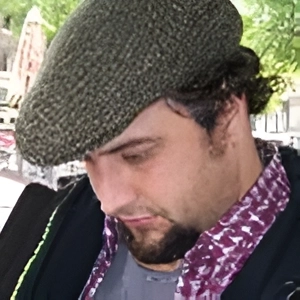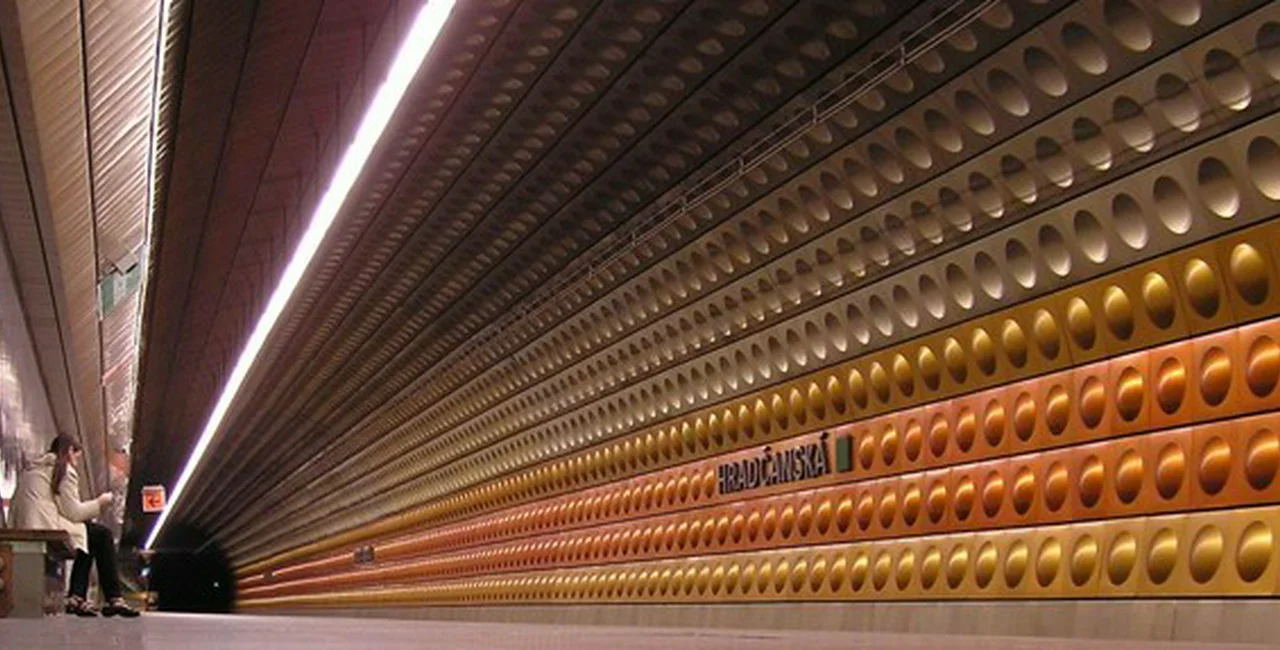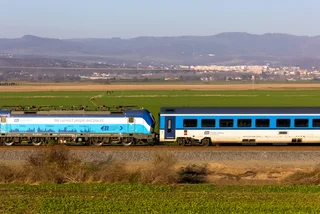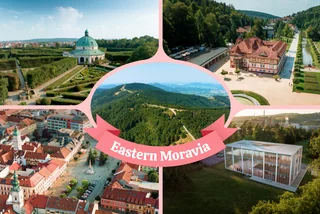In the first section we looked at some hidden aspects of the Prague Metro and their history. In this second part we’re going to focus on what is right in front of you, starting with the station design.
Showing Their Colors
The stations along the A Line (Green) from Hradčanská to Želivského have to be among the most easily identified of Prague’s underground metro stations. Colorful anodized aluminum plates announce the train’s arrival at each station. Practically every time I’m at Staroměstská, Malostranská, or Muzeum, I see someone snapping a picture of the dimpled and bumpy sides of the tunnels.
The plates are a mix of “champagne” and a color unique to each station, e.g. Staroměstská has red ones to distinguish it from the others. The design was the brainchild of Jaroslav Votruba, whose initial plan didn’t include the bumps.
“For a long time, it wasn’t known how the interior would be done,” said Evžen Kyllar, one of the architects involved in the construction of the Metro. Mr. Kyllar explained the convex and concave forms, known respectively as prsa (breasts) and antiprsa, were added to give stability.
“If the surface were flat, it would warp from the heat. The circular segment strengthened the plate,” he said. As he spoke, his hands fashioned the space in front of him. Pillars were signaled with an up and down gesture. The word ‘platform’ was accompanied by his hands moving out. It was like he was conjuring up the structures as we spoke.
Mr. Kyllar was more closely involved with some of the designs on Line B (Yellow). The intention was to achieve a different effect, so each line had its own individual character. The glass ‘lenses’ at Náměstí republiky were partly his idea.
“The lenses have a cut of a certain angle which creates a reflection of light so that it reflects directly. It means that on the outer surface of the tiles, it isn’t necessary to use any other covering,” he said. Most noticeably, the concave lenses create the illusion that they bubble outward. In addition, their reflective surface ensures less light is lost. Much of Line B’s decorative features were damaged during the 2002 floods and had to be replaced.
An additional illusion was at least attempted for the stations on Line C (Red). The stations are meant to look like continuations of the world at street level. “The transition of the street into the underground is quite an interesting trick,” Kyllar said.
False Starts and Unfulfilled Plans
The plan to build the metro was touted back in the 1930s. For a long time, it was thought that a metro system would damage the subterranean historical structures, such as cellars and basements.
For this reason, the green line is especially deep so that it doesn’t disturb the heritage and it can go beneath the Vltava. The downside is the length of the platform to surface journey.
“It prolongs the time spent in the tunnels,” Mr. Kyllar said, referring to the distance. The time is even longer today because the escalators run at 0.75 m/s, instead of 0.9 m/s, as they did in the past.
Name Changes and Hidden Artwork
It should come as no surprise that since the Metro was built during the communist era, the names for some of its stations and the accompanying artwork were chosen to celebrate heroes and key events as determined by that particular ideology.
The former names are:
| Today | Former Name |
| Dejvická | Leninova: named after V.I. Lenin – the former leader of the USSR |
| Florenc | Sokolovská: named after the sports group Sokol |
| Anděl | Moskevská: named for the Moscow / Prague “friendship” |
| Jinonice | Švermova: named after Jan Šverma, a communist politician |
| Nové Butovice | Dukelská: in honor of the Battle of Dukla Pass |
| Nádraží Holešovice | Fučíkova: named after Julisu Fučík, a communist writer, executed by Nazis |
| Vyšehrad | Gottwaldova: named after the first communist president, Klement Gottwald |
| Pankrác | Mládežnická: named for the communist youth movement |
| Roztyly | Primátora Vacka: named after Prague’s first communist mayor: Václav Vacek |
| Opatov | Družby: literally, it means “of comradeship” |
| Háje | Kosmonautů: for the Soviet space program. |
Some of the stations bear traces of their former identities. Anděl has in its southern vestibule (the one for the bus station on Na Knížecí) a relief with Moskva/Praha still built into the wall. Other artwork isn’t so visible.
For example, in the vestibule of Dejvická, on the Evropská Street side, a large bronze portrait of the station’s former namesake presented his profile to commuters coming and going. (Click on this link for a picture.) According to the article, the portrait of the communist leader hides behind, amusingly enough, a newsstand. A similar small business at Staroměstská is used to conceal a mosaic celebrating the “February Coup” of 1948, when the communists came to power.
It wasn’t just the connection with the past regime that made changes welcome. According to Pavel Fojtik, the head of the archive at the Prague Transit Company, the names were confusing because people had a tendency to associate the names with already existing landmarks, and assumed the station was close to the similarly named street or square when it wasn’t.
In the past, just as today, the stations have nicknames. Many of them are abbreviations: I.P. Pavlova is Ípák and Náměstí míru is Mírák. It stands to reason that Leninova would be Leninka. But some of the names are quite creative. Which station are people referring to when they talk about Slintáč or Slinták? If you thought I.P. Pavlova, then you’re right. It’s from the Czech verb slintat – meaning to drool – a reference to the experiments with dogs made by psychologist I.P. Pavlov, whom the station is named after.
On the Wagon
The Metro’s continuity with the past extends to some of the wagons in service. On lines A and B you will find 81-71M, a modernized version of the original 81-71, which was originally produced by the Metrowagonmash. The last of the original 81-71s were replaced in 2009, so if you were here then you were riding a bit of history. On Line C, you will see the very new Siemens-built M1s.
The older trains – the Ečs – were fully replaced by 1997 because they were seen as being too old and outdated. You can see of them at the Public Transport Museum.
You may remember from the previous article that we mentioned a rumor which alleged the Soviet trains were chosen after an act of sabotage on the Czech prototype – a story refuted by the head archivist, Mr. Fojtik.
The prototype was called the R1. Only two were made. As you can see from the link, the sense of injustice surrounding which wagons were used still exists.
Tunneling On
The story of the Metro doesn’t end here. The system is currently being extended from Dejvická to Motol with four new stations: Bořislavka, Veleslavín, Petřiny and Motol. The extension should be finished in 2014.
An open day in January 2013 gave an idea of the construction. The public could walk part of the tunnel from Veleslavín through Petřiny and out to Vypich for a total of three kilometers. No further secrets revealed themselves here, only the ingenuity and scale involved in constructing these tunnels.
The new extensions may not be shrouded in the same secrecy as when the Metro was built, but the system is sure to continue influencing Prague.
Photo: Metroweb
Related articles
- Getting to the Prague Airport Is Going to Be Tricky for Awhile
- Prague among Top 3 European Cities For Public Transport Use
- Free Wi-Fi at Prague Metro Stations to Begin this Month
- Prague Transport Fines to Be Slashed In Half—But There’s a Catch
- The Hidden Meaning Behind the Prague Metro’s Stunning Color Scheme












 Reading time: 6 minutes
Reading time: 6 minutes 




























